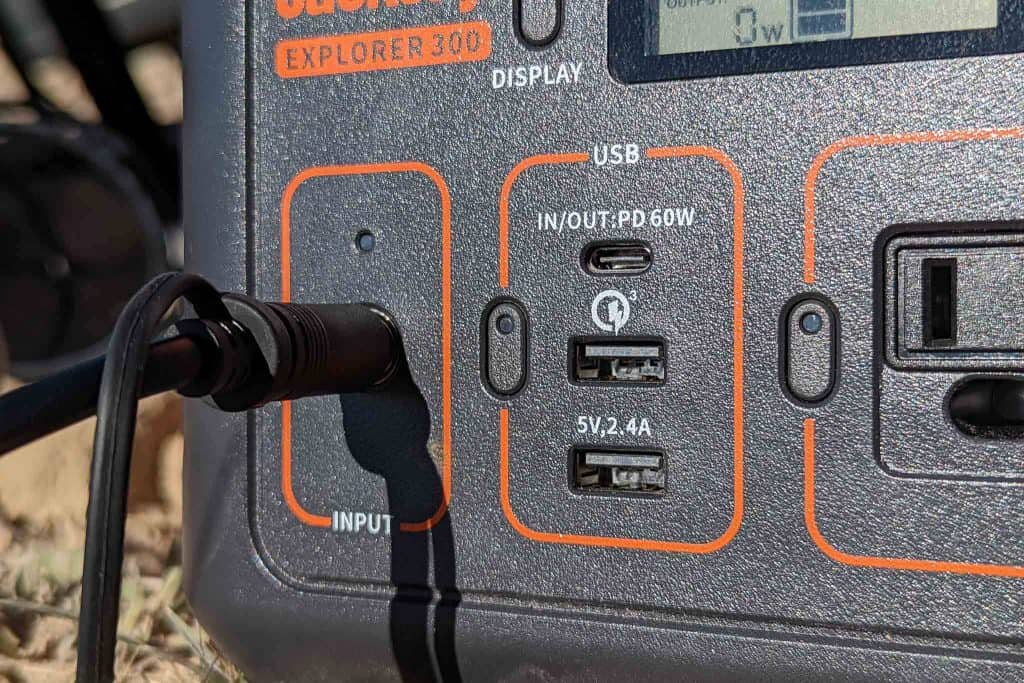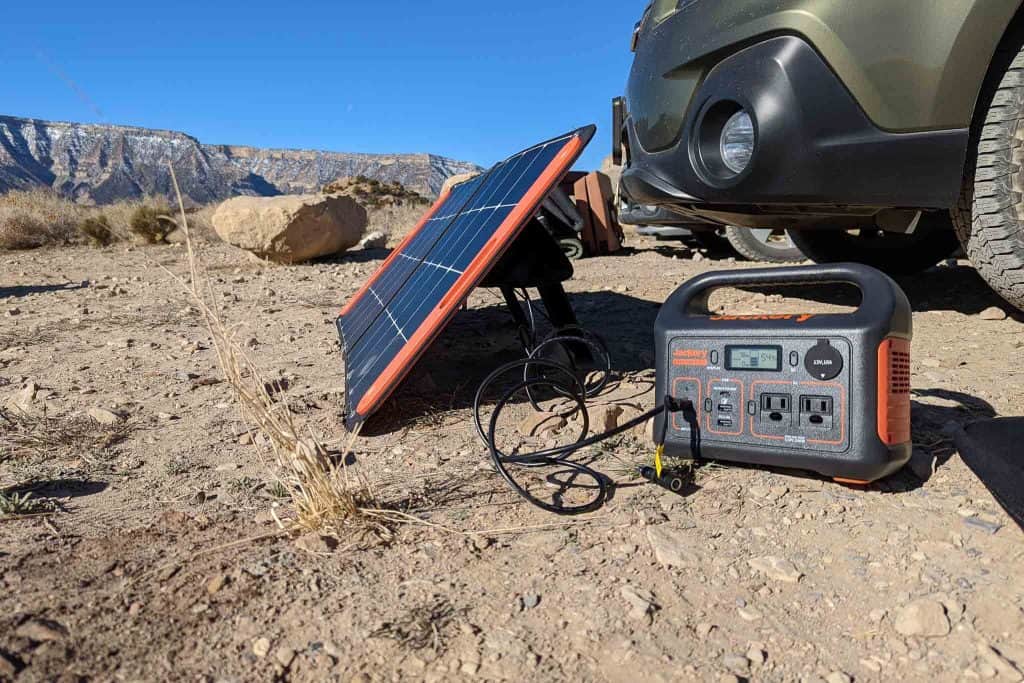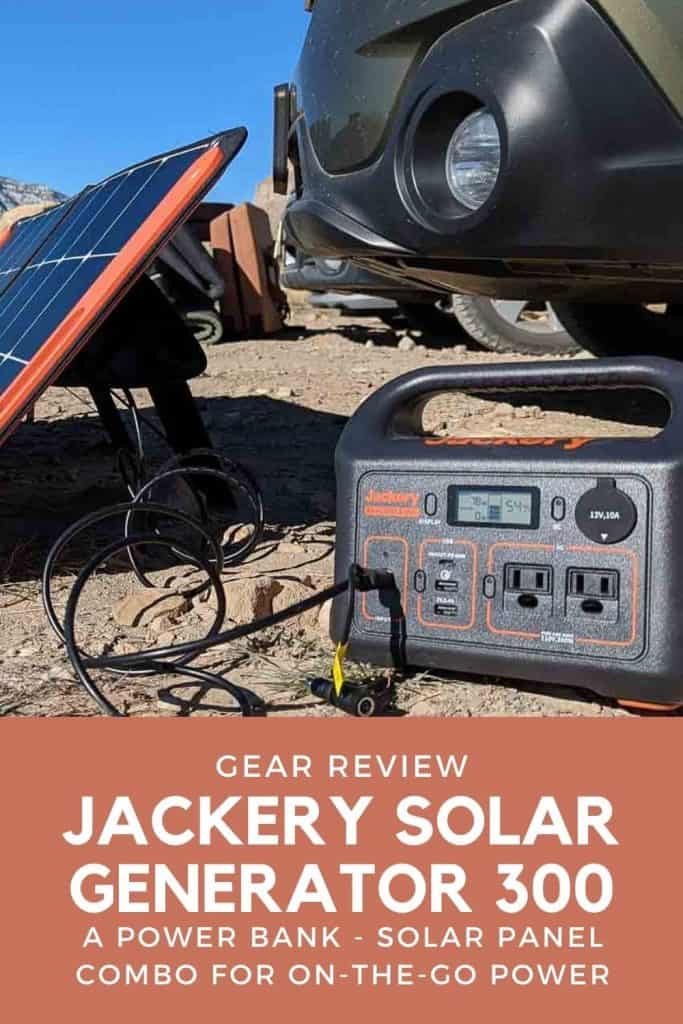The Jackery Solar Generator 300 is a combination package of the Jackery 300 and a SolarSaga 100W Solar Panel. The Jackery 300 is a 293Wh power bank weighing 7.1 lbs / 3.2 kg with one USB-C port, two USB-A ports, two Type B outlets, and a 12V car port.
It’s a power bank with enough capacity to reliably power larger devices like laptops, powered coolers, televisions, or drones, but not so large that you would want to rely on it as the sole source of power for an extended off-grid expedition. It’s designed to be portable, easily rechargeable, and practical.
Here’s everything you need to know about the Jackery Solar Generator 300.
Overall
Testing Conditions
I used the Jackery Solar Generator 300 for a month traveling through California, Nevada, and Utah – mostly living out of my car and camping along the way. I charged the Jackery Explorer 300 exclusively with a SolarSaga 100W solar panel during this time and exclusively used the 300 to charge all my devices (phone, camera, laptop, smaller power banks, headlamps, watch, etc.) during this time.
Pros and Cons
+ Lightweight and compact
+ USB-C port with Quick Charge output
+ Two USB-A ports and two Type B outlets
+ Can be recharged via car, wall outlet, or solar
+ Charges from 0 to 80% in 3.5 hours
– No measure of the time remaining on the charge
– Pass-thru charging is not recommended
– Dim display screen
– No discount for buying bundled items
The Specs
The following information reflects the Jackery Explorer 300 only. The SolarSaga 100W specs can be found here.
- Weight: 7.1 lbs / 3.2 kg
- Dimensions (in): 9.1 x 5.2 x 7.8
- Dimensions (cm): 23 x 13.3 x 19.9
- USB-C Ports: 1
- USB-A Ports: 2
- Type B Outlets: 2
- Operating Usage Temperature: 14-104°F (-10-40°C)
- Capacity: 293Wh (14.4V, 20.4Ah)
- Cell Chemistry: Li-ion NMC
- Lifecycle: 500 cycles to 80%+ capacity
- AC Output: 110V, 60Hz, 300W (500W Surge)
- USB-A Output: 5V, 2.4A
- Quick Charge 3.0 Output: 5-6.5V, 3A / 6.5-9V, 2A / 9-12V, 1.5A
- USB-C PD Output: 5V, 9V, 15V, 20V, 3A
- Car Output: 12V, 10A
- DC Input: 12V-30V (90W Max)
- Recharge via AC Adapter: 4.5 hours
- Recharge via 12V Car Adaptor: 5 hours
- Recharge via SolarSaga 100W: 5 hours
- Recharge via Electric Generator: 4.5 hours
- Country of Origin: China
- MSRP: $599.98 (Jackery 300 alone, $299.99)
The Features
- No gasoline, fumes, or noise during operation
- Compact, lightweight design, it’s easy to carry
- Emissions-free energy source and reliable battery management system make it safe enough for indoor use
- Can be recharged within 3.5 hours from 0-80% by a SolarSaga 100W solar panel.
- 2 AC outputs, 60W PD USB-C, QC3.0 USB-A, USB port, and 12V car port

Photo Gallery















The Good
The Portability: The Jackery Solar Generator 300 is easy to bring with you at just 7.1 lbs / 3.2 kg for the Jackery Explorer 300 and 10.33 lb / 4.69 kg for the SolorSaga 100 solar panel. They both have handles making them easy to carry and the Explorer 300 is small enough that you could fit it into a backpack (or under a table/next to you somewhere) if you wanted to.
The USB-C Port: The Jackery Solar Generator 300 has a single USB-C port which is good. I wouldn’t even want to consider a power bank without at least one USB-C port. Honestly, I wish there was a second one available. The USB-C port can be used as either an input (to charge the Jackery 300) or as an output (to charge a device). At 60W, it’s more than capable of powering USB-C devices – even laptops and tablets.
The Solar Charging: The SolorSaga 100 solar panel does an excellent job of charging the Jackery 300 – provided you have it out in direct sunlight. I was easily – and quickly – able to charge the Jackery 300 to 100% on mornings in the Utah desert and even when there’s cloud cover, you can still get some juice from the solar panel. Charging from zero – in direct sunlight – the panel will take approximately 5 hours to charge the Jackery 300 to 100%. The solar panel is compatible with other Jackery units, as well.
The Operating Temperatures: One thing I worry about when traveling in and living out of my car is the temperatures my car (and therefore my gear) will experience. I often find myself in areas where temperatures are either exceeding 100°F / 38°C or dropping below freezing. Fortunately, the operating temperature range of the Jackery 300 is 14-104°F (-10-40°C). I’ve yet to have a problem with it in either the heat or the cold.

The Okay
The Panel Size: The Jackery Solar Generator 300 comes with a SolarSaga 100W which isn’t compact by any measure. The panel folds in half (with a handy magnetic closure) and measures 24 x 21 x 1.4 in (610 x 535 x 35 mm) folded or 48 x 21 x 0.2 in (1220 x 535 x 5 mm) unfolded. It is thin and does store nicely so long as you have somewhere flat to stick it (I’ve put it at the bottom of my roof box or between folded-down seats in the past. I’ve been pretty rough with it and it’s held up surprisingly well.
The Time Remaining: A drawback of the Jackery Explorer 300 is that despite having a battery percentage remaining on the unit, there’s no indication of time remaining until empty. This is to say, if you plug in your laptop to work, you’ll have to gauge the remaining time you have based on the time that elapses between checking to see what battery percentage is left.
The Buttons: To begin charging with the Jackery 300 you need to hit a button adjacent to the plugs you will be using to turn them on. I usually find myself having to do this either in the dark or while blindly reaching into my car and finding the buttons a tad annoying. Perhaps if they had small lights (when off – they have lights when on) or were embossed or texturized to make them easier to find/push – maybe switches instead? I don’t know.

The Bad
The Bundle: One thing that stands out to me about the Jackery Solar Generator 300 is that despite buying what’s essentially a bundle of the Jackery Explorer 300 and the SolarSaga 100 solar panel, there’s no price break. The set is the same price as it would be were you to purchase the Explorer 300 and the SolarSaga 100 separately. Maybe there’s an incentive I’m missing here, but I never understand why when the combo price is the same as all its parts added together.
Who is it for?
The Jackery Solar Generator 300 is the ideal piece of gear if you want to keep your small to medium electronics charged while traveling or camping off the grid. If you’re a small group (maybe two or three people), the system should be able to provide you with all the power you need to keep your devices charged – particularly if you plan on taking full advantage of the solar panel.
If you’re looking for something to power a refrigerator, blender, or other large electronics that may be more associated with van life than car camping, then you’ll want something larger than the 300. That said, the 300 isn’t a bad thing to have around in case you need some power in a pinch.
I’ve also found the 300 incredibly useful for powering my laptop in places where power outlets aren’t readily available (i.e. now I can sit anywhere at any Starbucks to work).
Popular Alternatives
| POWER BANK | CAPACITY | PRICE | WEIGHT | USB PORTS | OUTLETS |
|---|---|---|---|---|---|
| Jackery Explorer 300 | 293Wh | $300 | 7.1 lb / 3.2 kg | 1 USB-C, 2 USB-A | 2 Type B, 1 Car 12V |
| Jackery Explorer 240 | 240Wh | $220 | 6.6 lb / 3 kg | 2 USB-A | 1 Type B |
| Anker 521 Portable Power Station | 256Wh | $250 | 9.57 lb / 4.34 kg | 1 USB-C, 2 USB-A | 2 Type B, 1 Car 12V |
| Goal Zero Yeti 200X | 187Wh | $300 | 5 lb / 2.27 kg | 2 USB-C, 2 USB-A | 1 Type B, 1 Car 12V, 1 12V 6 mm |
| EcoFlow RIVER | 288Wh | $349 | 11 lb / 4.99 kg | 1 USB-C, 3 USB-A | 3 Type B, 1 Car 12V |
| ROCKPALS 300W | 280.8Wh | $286 | 7.7 lb / 3.5 kg | 1 USB-C, 3 USB-A | 1 Type B, 1 Car 12V, 2 12V 5 mm |
| ROCKPALS Freeman 300W | 281Wh | $300 | 7.3 lb / 3.31 kg | 1 USB-C, 3 USB-A | 1 Type B, 1 Car 12V, 1 12V 5 mm |
Wrap Up
The Jackery Solar Generator 300 strikes a nice balance between portability and battery size. I love that I can fit the Explorer 300 into my backpack or tuck it away discreetly in my car. It has more than enough power to keep all my small electronics charged and to keep my laptop functioning on the road.
The SolarSaga 100 works well and, in direct sunlight, can charge the Explorer 300 surprisingly quickly. I do wish it had one more USB-C port, but I’m grateful for the one for now.
Questions, comments, or personal experience with the Jackery Solar Generator 300? Leave a comment below or get in touch and let me know!
Check out the Jackery Solar Generator 300 here.
This page may contain affiliate links, which means I may receive small commissions for purchases made via these links at no additional cost to you. This helps to pay the bills and keep the site up and running. Thank you for your support!


